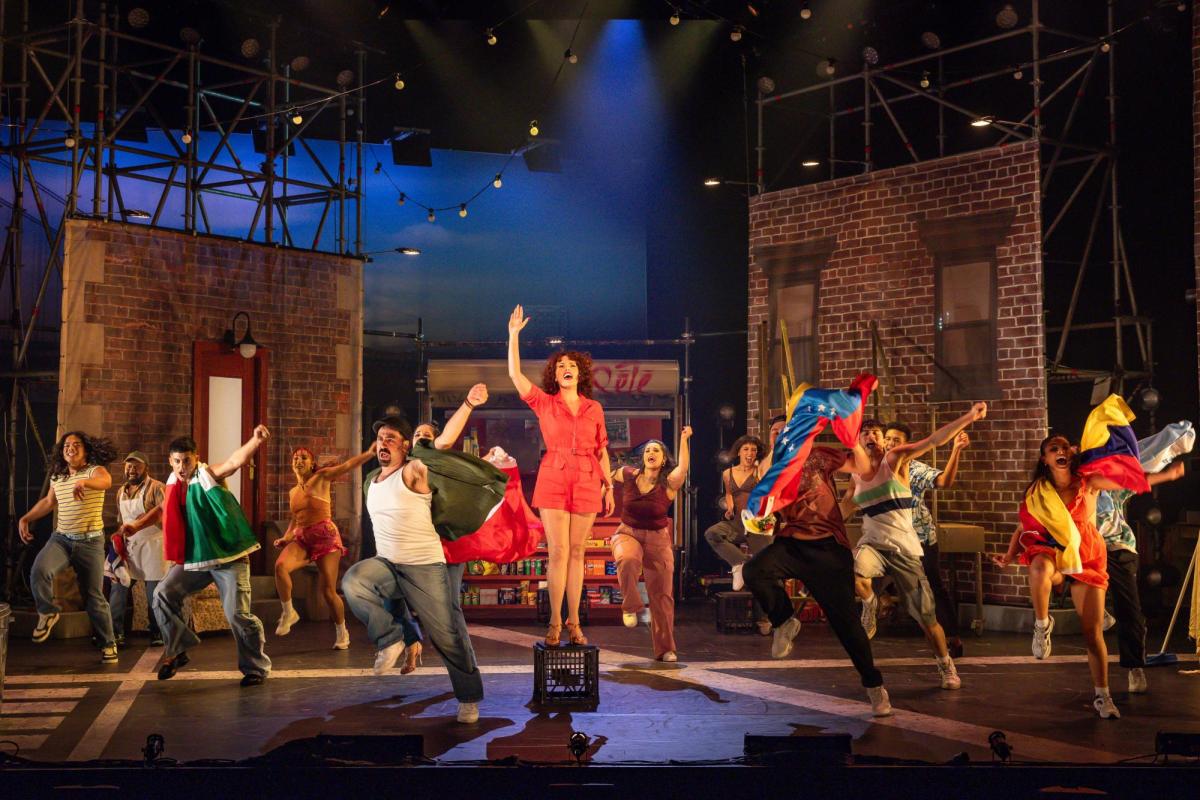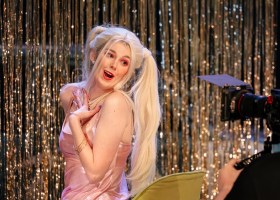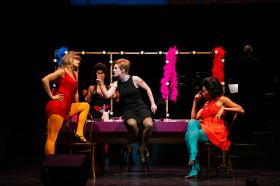In the Height’s music and lyrics were written by Lin-Manuel Miranda. Miranda is Broadway royalty with credits for several Disney hits (such as Moana and Encanto) to his name, as well as the cultural phenomenon, Hamilton. In the Heights is the show that started that journey, opening on Broadway in 2008. Its casual mix of salsa and hip hop made it an instant success with glowing reviews, 13 Tony nominations including Best Musical (which it won), and a plethora of other awards.
As they swelter in a 4th July heatwave, the residents of New York’s Washington Heights crave an escape from the barrio where ‘Everybody got a dream’ of love and leaving. Bodega owner Usnavi (Ryan Gonzalez) pines for local beauty Vanessa (Oliva Vásquez), while daydreaming about a simpler life in the Dominican Republic. Vanessa, however, is preoccupied with her desperate attempts to get a downtown apartment.
The hairdressers at the local salon distract themselves with gossip. Nina (Olivia Dacal) – the one who made it out – is distraught at having to return after losing her scholarship to Stanford university and is fretting over breaking the news to her parents.
When Usnavi discovers one of his customers has bought a winning lottery ticket, everyone fantasises about what they would do with the $96,000 prize money. Usnavi’s abuela, Claudia (Lena Cruz), has the winning ticket, but when she dies of heatstroke, it makes everyone reconsider their desire to escape.
The musical was last seen at the Opera House Concert Hall in 2019. Both Gonzalez and Vásquez revitalise the roles they have previously played in this production. They are joined by Broadway veteran Janet Dacal and a number of young Australian actors making their debut. Gonzalez plays Usnavi with a cheery charismatic charm and conviction, while Vásquez belts out her solos with fiery passion.
Dacal, as salon owner Daniela, ignites Act II with her sassy, spirited rendition of ‘Carnaval del Barrio’. Decal’s niece, Olivia, makes a commendable and confident stage debut as Nina, while stage stalwart Angela Rosero gives a deliciously spicy performance as Nina’s mother Camilla. Lena Cruz’s performance as Claudia is also well-considered and poignant.
The swing section has been pared back to accommodate staging in the smaller Drama Theatre, but Mario Acosta-Cevallos, Kara Sims and Mariah Gonzalez still manage to strut their salsa stuff with style and Rome Champion, and Malena Searles demonstrate some wicked hip hop.
Read: Opera review: Two Remain, fortyfivedownstairs
With fewer swing members and constrained space, however, the ensemble struggle to create the vibrant impact of earlier productions. The set, too, is limited by the more compact theatre, feeling more like an alleyway than a suburb. On the upside, the compact staging delivers a more intimate experience. Consequently, while perhaps not as dramatic and vibrant as earlier versions, this production offers a more heart-warming tribute to the immigrant communities that provided its inspiration.
In the Heights, Sydney Opera House
Music and Lyrics by Lin-Manuel Miranda
Book by Quiara Alegría Hudes
Director: Luke Joslin
Producer: Joshua Robson
Choreographer: Amy Campbell
Music Director: Victoria Falconer
Associate Director: Clary Riven
Associate Choreographer/Ensemble: Tash Marconi
Set Designer: Mason Browne
Original Set Design (2018): Simon Greer
Lighting Designer: Jasmine Rizk
Costume Designer: Keerthi Subramanyam
Sound Designer: Dylan Robinson
Casting Director: Rhys Velasquez
Cultural Consultant: Will Centurion
Rehearsal Stage Manager: Jessie Byrne
Line Producer: Madeleine Gandhi
Production Stage Manager: Alex Duffy
Stage Manager: Lillian Lee
Consulting Producer: Kaleigh Wilkie-Smith Giles
Assistant Stage Managers: Maddison Craven and Mackenzie O’Byrne
Cast: Ryan Gonzalez, Olivia Dacal, Barry Conrad, Olivia Vásquez, Steve Costi, Lena Cruz, Janet Dacal, Tamara Folgia Castañeda, Alexander Palacio, Angela Rosero, Richard Valdez, Jervis Livelo
In the Heights will be performed until 25 August 2024.






